Home » Hunting Dogs » Small Munsterlander – Heathland Quail Dog
Small Munsterlander – Heathland Quail Dog
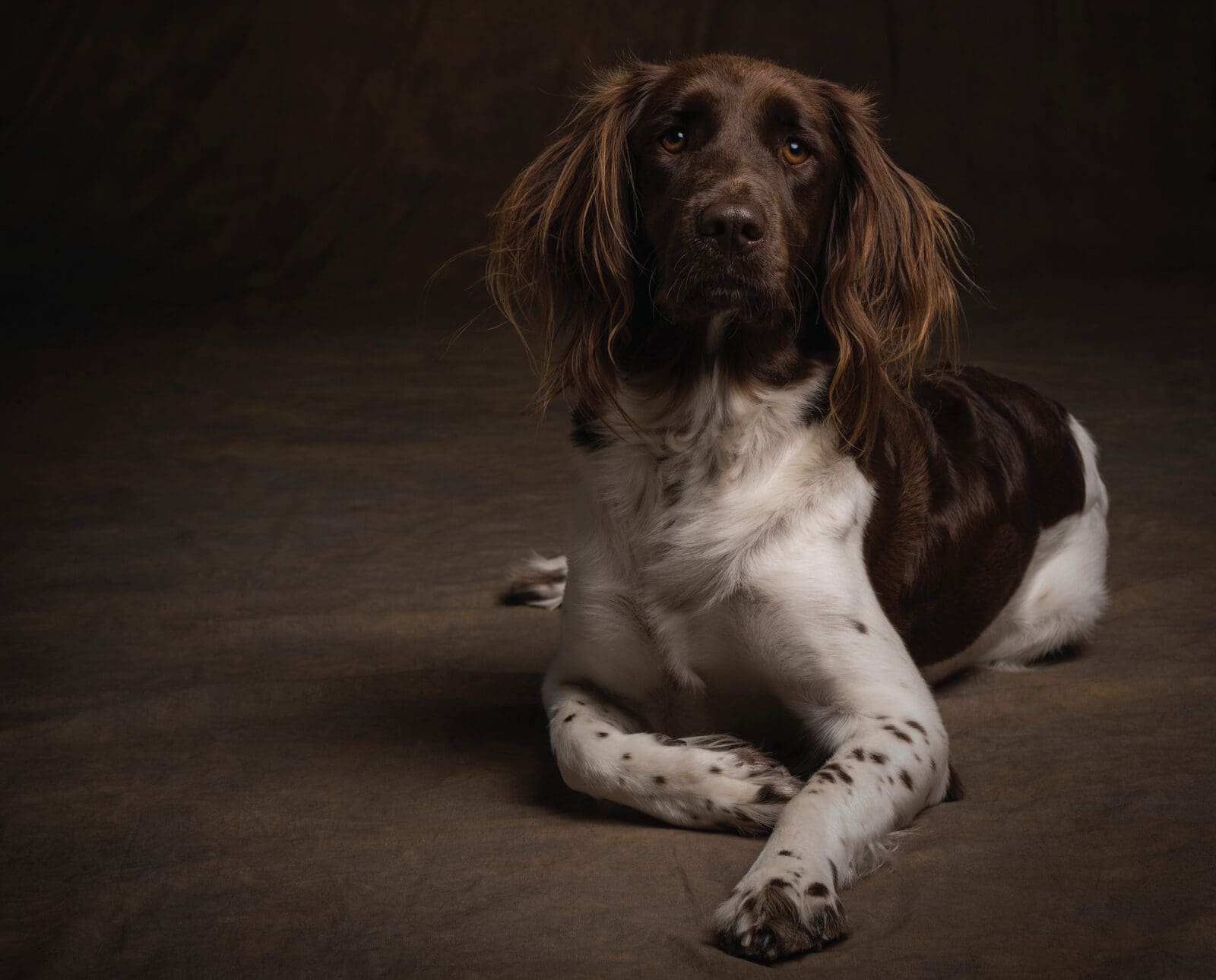
Gabby Zaldumbide is Project Upland's Editor in Chief. Gabby was…
Dive deep into the Small Munsterlander’s journey from obscurity to a top hunting breed. Discover its rich history, unique traits, and why it’s a favorite among hunters.
Small Munsterlanders, fortunately for me, are one of the pointing dog breeds I’ve gotten to know in person. Feisty, handsome, and highly energetic, this breed is the tenth most popular bird dog breed in the Project Upland community, according to our annual survey. It’s also the third most popular versatile hunting dog breed in Europe. This is likely due to their broad skillset that includes searching, pointing, flushing, retrieving, tracking, and water work.
Listen to more articles on Apple | Google | Spotify | Audible
“Here in the U.S., the breed is continuing to enjoy growth in popularity,” said Nancy Anisfield, the creative director of Ugly Dog Hunting Company. “However, it is important to research breeders and lines to get the best package of size, coat, and fundamental hunting instincts.”
When it comes to owning a Small Munsterlander (SM), they are friendly and dynamic companions. “Working and hunting with Rogue has been an experience, to say the least,” said Justin Bubenik, a Small Munsterlander owner. “The game drive and energy level I’ve witnessed is unmatched. My Small Munsterlander is constantly on the hunt, and it’s difficult for her to turn that off. That said, she’s still an excellent family dog and knows when to turn it down a notch indoors.”
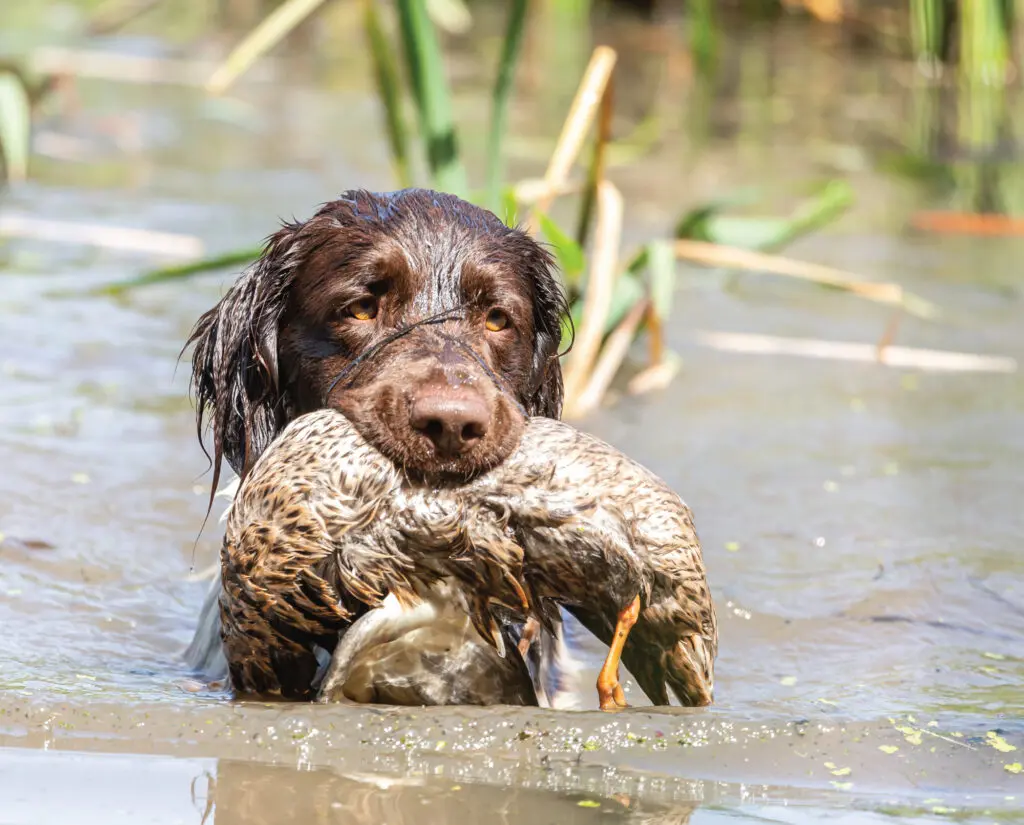
Pointing Dogs Volume One: The Continentals and Pointing Dogs Volume Two: The British and Irish Breeds author Craig Koshyk explores Small Munsterlander as a breed in Volume 1. See pages 269 through 276 for Koshyk’s chapter on Small Munsterlanders.
Spoiler alert: The next chapter is on Large Munsterlanders. However, although Large Munsterlanders share a name with Small Munsterlanders, they are not a size variant. “The small Munsterlander – the smallest German pointing dog – is a breed separate from the large Munsterlander, not merely a size variant. Both breeds are skilled pointers, trackers, and retrievers, but their temperament, conformation, and coat colors differ,” said Anisfield.
Small Munsterlander Characteristics, Training, and Ability
| Characteristic | Details |
| Size | Small to medium.Males: 52-56 cmFemales: 50-54 cm |
| Tail | Uncropped |
| Coat | Medium length, dense, and flat. The face’s coat should be short and smooth, but feathering should be present on the legs and chest |
| Coat Color | Brown and white, white-brown ticked (roan), and potentially small tan markings |
| Maturity | They may be late bloomers in terms of pointing |
| Health | Some hip dysplasia and epilepsy |
| Character | Appealing, dynamic, friendly, and happy |
| Other Notable Features | They are a great choice for all upland, waterfowl, and even big game hunting |
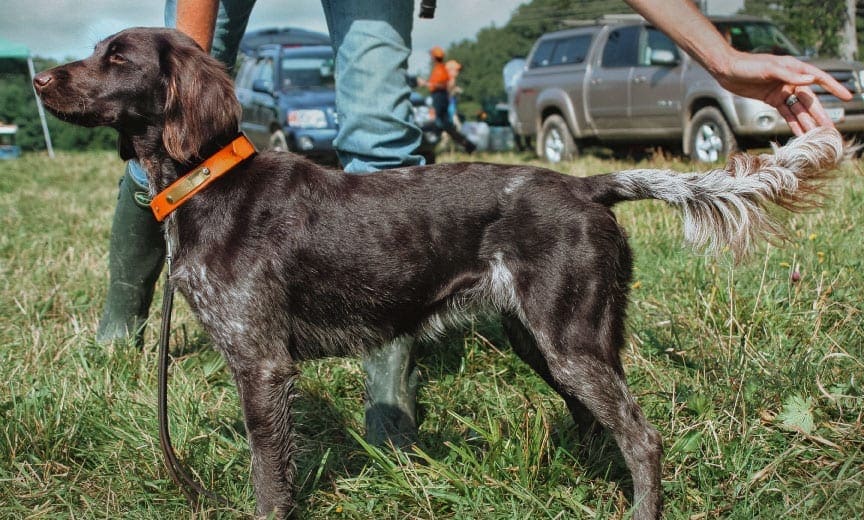
Smart and attentive, Small Munsterlanders are very trainable dogs. “A firm but gentle hand is what most Small Munsterlander breeders recommend when it comes to training,” wrote Koshyk. Truthfully, some can be somewhat stubborn.
“They are a hugely intelligent breed, but with those smarts has come challenges,” said Justin. “This includes a tendency to try to take advantage of an inattentive or overly sympathetic handler and a certain stubbornness that is less than endearing at times.”
American breeder Chris Gosch has gone on the record about what you can expect when training your Small Munsterlander. He says owners looking for cookie-cutter training programs will likely feel disappointed. Train at your hunting dog’s pace instead of adhering to a generic program. “Most of my dogs were like a light switch,” he said. “You could see when they finally figured it out and started hunting versus just running around in the woods.” If you have the patience to wait for the moment when all the training finally clicks, even if you have to wait a few seasons, you’ll be rewarded with an excellent hunting partner.
Small Munsterlanders tend to be close-working dogs with an animated field search. The breed’s average range is 50 yards. However, they might go out as far as 200 yards. “Like range, there is some variation on the pointing ability and style among ,” said Koshyk. This is because some dogs develop their pointing instincts quite late compared to others. Chris Goesch has seen some of his dogs point at four months and others at 15 months. He also has dogs that are natural backers and others that have no backing instinct at all. In the water, some Small Munsterlanders will take to water work more slowly than others. In other words, each Munsterlander may vary.
Unlike field searching and pointing, the Small Munsterlander’s retrieving and tracking instincts are reliably strong. Most of them show the desire to retrieve very early in age. Additionally, they’re known around the world for their ability to track. “Today in Germany, the breed is used to track big game,” said Koshyk. “In North America, Small Munsterlanders have been proven to be excellent trackers of wounded birds and hare.”
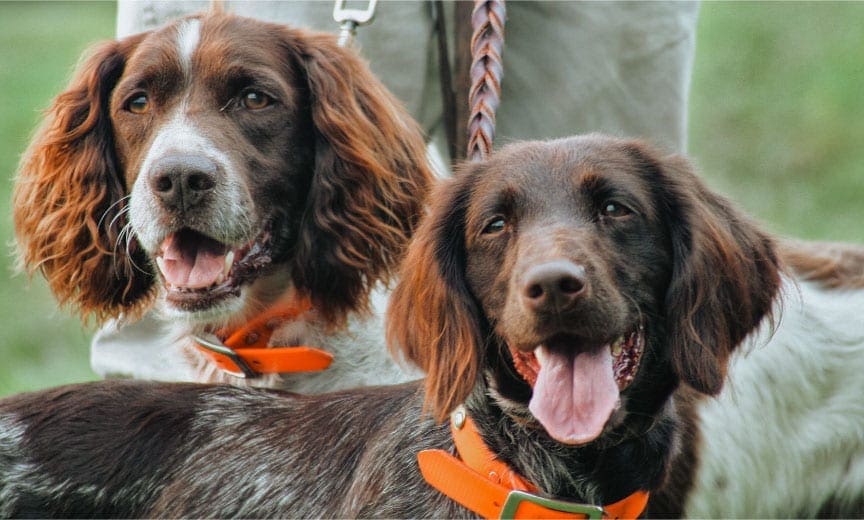
Their coats can be liver and white, liver-white ticked, or roan.
Small Munsterlander Clubs, Tests, and Trials
The Small Munsterlanders parent club is the Verband fur Kleine Münsterländer Vorstehhunde. You can also find European clubs in Denmark, France, Austria, Sweden, Switzerland, the Czech Republic, Belgium, and the Netherlands.
The Small Munsterlander Club of America (SMCA) represents the breed in the United States and Canada. The North American and the American Kennel Club recognize Small Munsterlanders as a breed.
“In Germany, most breeders participate in the Jagdgebrauchshundverein (JGHV) testing system and follow similar testing and breeding regulations as other German breeds,” said Koshyk. Germany also conducts tracking, retrieving, and independent forest search tests in addition to JGHV. North American breeders, especially those in the SMCA, participate in North American Versatile Hunting Dog Association (NAVHDA) tests. Some SMs have even become Versatile Champions.

Small Munsterlander History
Small Munsterlanders were originally known as Spion, Spannjer, or Wachtelhund, which means Heathland Quail Dog. Think about the word espionage; the original names of this little German pointer meant “spy” or “snoop,” which “may come from the fact that these dogs were known for their ability to work their way into the thickest cover in search of game,” said Koshyk.
In the pre-1800s, Spions were bred to be trackers. This was because any game not recovered meant one less meal on the table. When this style of put-meat-on-the-table hunting started to die out in the mid-1800s, other dogs, like English Setters, Pointers, and French spaniels, rose in popularity. It was fully believed that the little spy dogs had gone extinct.
That remained the case until 1900. Hermann Löns, a poet and sportsman, published a public call to action in a magazine; he was looking for the Red Hanoverian Heath Hound, another nearly extinct dog breed. He traveled to Lower Saxony in search of the breed. To his surprise, what he found living on a few farms in Westphalia wasn’t a Red Hanoverian, but a Spion!
Heitmann, a Westphalian Spion breeder, had been breeding his own line since 1877. “He had even used German Longhaired Pointers from time to time, keeping only those pups that had Spion traits,” said Koshyk. In 1911, Löns found another pool of Spion genes in Dorsten, a town in Westphalia. They were related to Heitmann’s dogs but hadn’t been crossed with them in a long time. Each breeder used the other’s dogs to strengthen their own lines, perpetuating the little spy dog into the future.
The first club was founded by Löns and called the Verband für Kleine Münsterländer Vorstehhunde (Club for Small Munsterlander Pointing Dogs). It established the first Small Munsterlander stud book. However, the members couldn’t agree to allow or not allow a roan version of the brown and white coat, so it split. Löns started another club, the Deutsch Heidewachtel Club. Eventually, the two clubs rejoined, but they split again in 1947. They rejoined in the 1950s to form the Verband für Kleine Münsterländer Vorstehhunde. An international Small Munsterlander club was formed in 2006, and it helps to “broaden the genetic base of the breed, improve its health through shared information and experiences, assist in the importation and exportation of puppies and create an international stud book,” according to Koshyk.

However, there was a secret in the Small Munsterlander’s history. It was recently revealed that Löns had bred a Brittany to his line of Small Munsterlanders in 1918. He bought it from a ragpicker’s cart almost immediately after recognizing it as a Brittany (and creeping on the man and his dog as they hunted together). He intentionally did this to achieve a small, fast-moving, brown-roan-coated dog. Löns made it even worse; he registered the stud in the Small Munsterlander stud book. He lied about the dog, saying its coat was a genetic mutation, and later changed his story and said it was a German Long-haired Pointer.
Löns had only disclosed this information to one person: Elizabeth Brand-Böhmer. He asked her to keep his secret until his death, which she did when Löns died in 2006. She had kept it to herself for almost 40 years.
Whether you’re looking for your next Small Munsterlander or are thinking about getting your first one, adding a Small Munsterlander to your bird hunting family means you’re helping support the next generation of this once-nearly-extinct breed. “At the end of the day, there’s no other dog in my life that has given me more in terms of gratification and reward for the work put forth by both the dog and myself than my SM,” said Bubenik.
Gabby Zaldumbide is Project Upland's Editor in Chief. Gabby was born in Maryland and raised in southern Wisconsin, where she also studied wildlife ecology at the University of Wisconsin-Madison. In 2018, she moved to Gunnison, Colorado to earn her master's in public land management from Western Colorado University. Gabby still lives there today and shares 11 acres with eight dogs, five horses, and three cats. She herds cows for a local rancher on the side.

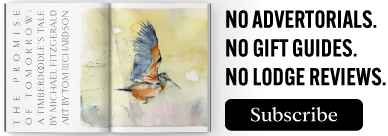
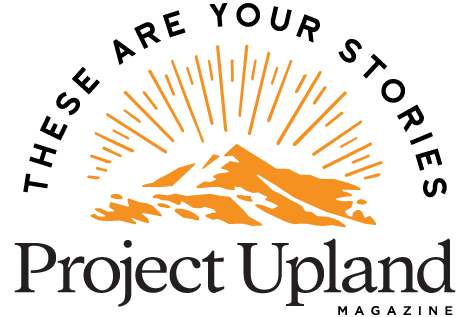

Short and sweet article,pretty much describes them in a few words. Both registry’s here in the US, Small Munsterlander Club of North American and Kliener Munsterlander, do hip certifications before approval for breeding, as such I don’t see where it’s a big concern, actually pretty low concern compared to other breeds. The one thing I don’t understand is the AKC reference, I don’t believe they have the SM’s as a registered breed yet, recognized but not registered, and hopefully they never will register them, because if they do then you will see health issues become a concern.
To my knowledge the sm is not in the akc. The club doesn’t desire to have the sm registered, for fears of going down the path of other “show” breeds that once were notable working dogs. The other general trait to mention is they are very biddable dogs that aim to please. They tend to be soft to harsh training. They will shut down under pressure that may be tolerable to other breeds. The article is accurate otherwise, especially in regards to the slowly developing point of the breed. Patience and wild bird contacts are important. The breed is versatile, loyal, and an excellent partner in the house and field.
Hey John, thanks for the feedback. You are correct that AKC does not register the small Munsterlander as we had no mention that they did. Per some research to clarify the subject a bit more. “On August 14, 2006, the AKC recognized the Small Munsterlander into its Foundation Stock Service (FSS) program, in response to a petition by an individual, not the SMCNA. This recognition by the AKC allows a purebred breed to continue to develop while providing them with an avenue to maintain their records. FSS breeds are not eligible for AKC registration. Some of the FSS breeds are approved to compete in AKC Companion Events which consist of obedience, agility, tracking and rally events.”
Contact the KLM-GNA Kleine Munsterlander Group North America.
KLM-GNA which was founded about 5 years ago is chapter of the KlM club in Germany and is required to follow all of the German Club’s breeding and testing regulations. GNA must use the JGHV for their testing requirements which includes a significant amount of work on fur bearing animals. Their program works well in Germany because over 70% of the animals harvested annually are fur bearing.
The SMCNA was founded by the first people who imported KlMs to the USA in the early 1970’s. By 1993, the Club had increased in size significantly. New breeding regulations, fundamentally based on the German Club’s, were formally adopted but modified to reflect how Americans hunt. The Club designated NAVHDA as it’s field testing organization because it’s national coverage (and their forms are in English).
I have had my SM for nearly three years. She was relatively easy to train, has great prey drive and a solid point. SM are great in the house and thrive with plenty of human contact. My dog routinely hunts with GSPs, while she tends to work closer she has not trouble keeping up with longer ranging dogs. SMCNA has done a great job of managing a breeding program. I would not consider a SM that did not come from a SMCNA OR Kleiner Munsterlander approved breeding. I hope SM never becomes an AKC breed.
this breed looks like a field bred springer spaniel. Is there any spaniel in their background? they sound like a springer as well in their training except that springers are flushing dogs rather than pointers. thanks in advance for any info.
It is possible that there was some spaniel in their background; accounts vary. Most likely the Brittany played a part in the early development of the breed.
I was just made aware of this article…. the two dogs featured In all photo’s are American Stark v die Hage tot Gouwe and Dizzy Miss Izzy v Loenerhof! Both imported from the Netherlands. Stark departed us in 2018 after 17 and a half strong years, he was tenacious, Izzy now 13 is still full of energy and a passionate hunter. These pictures were taken at her Navhda natural ability test In Bowdoinham, Maine, Thank you Nancy for taking these! i would be remiss in giving special thanks to Leana Amerian who was a great friend and mentor who taught me so much and without whom I would have never been able to get such enjoyment out of two great and very different from each other hunting dogs. She passed away last fall and left a great legacy behind. She is terribly missed.
Thanks for publishing the article.
The SM is a good breed. However, many (and especially the first-time handlers) buy into the exotic history and the profile of the breed and overlook their mild to severe lack of pointing instinct. Even compared to other German upland breeds.
This has always been as serious issue for the SM. I have not seen a SM that does not have a degree of this problem.
Some will fix it by the time they are 8-12 month. Some will always have a loose point and some, sadly, never develop it.
Unless you are an experienced handler and know how to deal with pointing issues the SM may not be your first choice.
Otherwise, they are excellent dogs, good pets, great trackers and retrievers. These are two things that you do not need to worry about. Otherwise, they make amazing dogs, they retrieve from land and water just as good as the lab. They track better than many other breeds.
Other point here that needs to be cleared out is the SM’s big game hunting in Germany. We should be very clear here what we mean by big game hunting. The most of pointing breeds can participate in driven hunts with limited scope. It is very rare for a pointing breed to perform the same task as Wachtelhund, meaning finding an old track, fallow it, find the game and drive or hold it at bay. This requires a very large area of cover and very independent and extensive browsing, which the vast majority of upland breeds are not equipped for. (And I hope they will stay this way.)
Unless the SM has a title S (Saujager – Boar hunter) in his name it is legally not a big game hunter.
Blood tracking is not hunting too.
that is one beautiful and amazing story along with that little secret kept for so long, a testament to friendship and love for dogs.